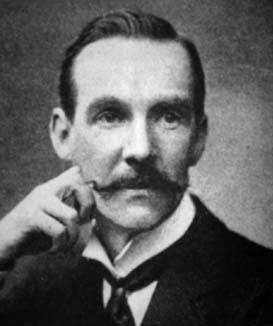
Ernest William Hobson
 المؤلف:
J C Burkill
المؤلف:
J C Burkill
 المصدر:
Biography in Dictionary of Scientific Biography
المصدر:
Biography in Dictionary of Scientific Biography
 الجزء والصفحة:
...
الجزء والصفحة:
...
 22-2-2017
22-2-2017
 773
773
Born: 27 October 1856 in Derby, England
Died: 19 April 1933 in Cambridge, Cambridgeshire, England

Ernest Hobson's mother was Josephine Atkinson. His father, William Hobson, was the editor of the Derbyshire Advertiser, jointly owning the paper and also playing a large role in local politics. Ernest was [2]:-
Brought up in rigidly Low Church surroundings ... [and] seems to have felt bitterly the fetters of dogmatism and resolved to shake them off.
He was not the infant prodigy that many mathematicians are, rather the reverse in fact for he was considered as a child to be without many gifts. He attended Derby School where he was well taught, but failed to shine until he was 13 years old when he suddenly amazed everyone by gaining distinction in the Cambridge Junior Local Examinations in mathematics, natural sciences, French and music. While at school [2]:-
... he developed strong views of rationalism, becoming ... an avowed radical and agnostic.
He studied at the Royal College of Science and gained a Whitworth scholarship in 1871 which enabled him to study physics with Frederick Guthrie at the Royal School of Mines. These two institutions combined in 1907 to become Imperial College of Science and Technology which was a College of the University of London from 1908. Hobson then won a mathematics scholarship to Christ's College, Cambridge, entering in 1874.
He graduated as Senior Wrangler (ranked first in the list of First Class students) in the Mathematical Tripos of 1878 despite, as noted in [2], being:-
... more notable as a thinker than as a calculator.
He was appointed to a fellowship at Christ's College in 1879 and taught at Cambridge for the rest of his life. For many years, however, he only taught at the College, playing hardly any role in university life outside College [2]:-
His work consisted in private coaching and in lecturing in Christ's on more or less elementary mathematics for the Pass and honours examinations.
Perhaps, rather surprisingly, he coached Philippa Fawcett, the Senior Woman Wrangler of 1890, despite his well known strongly held views against women. He married Selina Rosa Knüsli, who came from Glarus in Switzerland, in 1882 and continued with his College life until 1904 when he was appointed to a university lectureship. Cambridge had set up two new prestigious lectureships in the previous year, the Cayley lectureship and the Stokes lectureship. Hobson was the first appointment to the Stokes lectureship.
Hobson published A Treatise on Trigonometry in 1891 [2]:-
... which possessed a standard of rigour new to Cambridge.
He was introduced to modern analysis by Young and after this he began to make a real contribution to research. His research concentrated on convergence, in particular convergence of series of orthogonal functions.
His book Theory of Functions of a Real Variable published in 1907 was the first English book on the measure and integration developed by Baire, Borel and Lebesgue. Hardy believed that this work had been of major importance in the development of pure mathematics in Britain. Probably mainly due to this particularly influential work, Hobson was elected Sadleirian professor at Cambridge in 1910. The Sadleirian chair only became vacant that year because Forsyth had been forced him to resign the chair after a scandal resulted from his love affair with the wife of C V Boys. The Theory of Functions of a Real Variablewas a [2]:-
... solid book of reference, for which the mathematical world owes a debt of gratitude to the author, [but was] soon out of print and out of date. The leisure which Hobson enjoyed after his election to the Sadleirian Professorship enabled him to devote himself to its complete rewriting, and the second edition (1922-25) was double the size of the first. It is characterised not merely by a great breadth of information and by a critical and conscientious consultation of authorities of the most varied nationalities, but more especially by conspicuous objectiveness and fairness.
Another book which Hobson published was Squaring the circle in 1913. This is a delightful little work which I [EFR] greatly enjoyed reading. Entertainingly written, yet packed with useful information, it leaves me wishing that he had written more popular works.
Hobson was elected a fellow of the Royal Society in 1893, serving as a member of its council, and being awarded the Society's Royal Medal in 1907. He was an active member of the London Mathematical Society, being president of the Society 1900-2 and receiving the De Morgan Medal of the Society in 1920. He was also president of Section A of the British association at its meeting in Winnipeg, Canada, in 1909.
To many Hobson is better known for the Gifford lectures he gave on The domain of natural science at the University of Aberdeen in 1921-22 than for his mathematical contribution. This comment is in no way intended to minimise the value of his mathematical contributions, rather it is to emphasise the high regard in which his Gifford lectures were held. These lectures were published in 1923.
- J C Burkill, Biography in Dictionary of Scientific Biography (New York 1970-1990).
http://www.encyclopedia.com/doc/1G2-2830902024.html
Books:
- G H Hardy, Ernest William Hobson, Obituary Notices of Fellows of the Royal Society of London 3 (1934).
 الاكثر قراءة في 1850to1859
الاكثر قراءة في 1850to1859
 اخر الاخبار
اخر الاخبار
اخبار العتبة العباسية المقدسة


